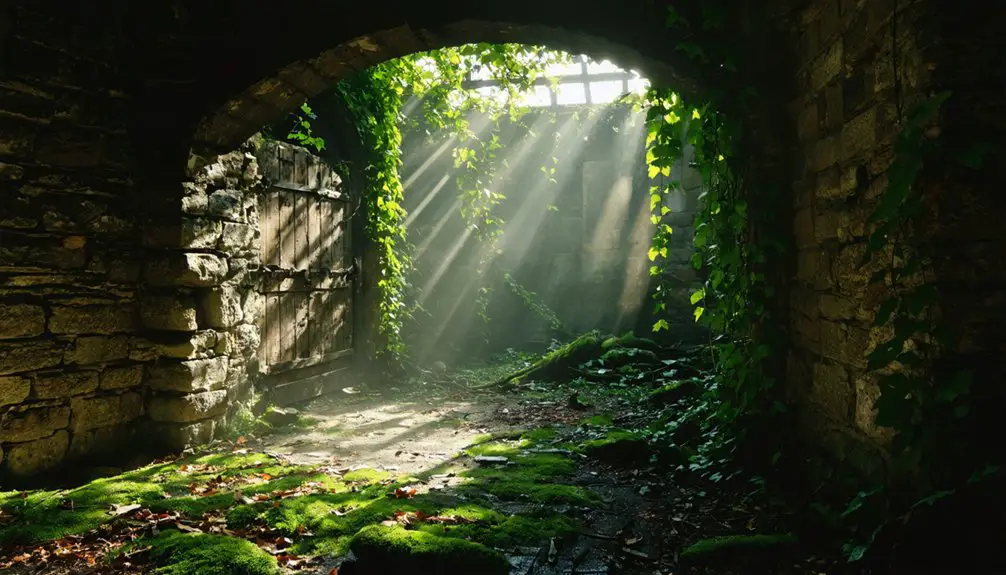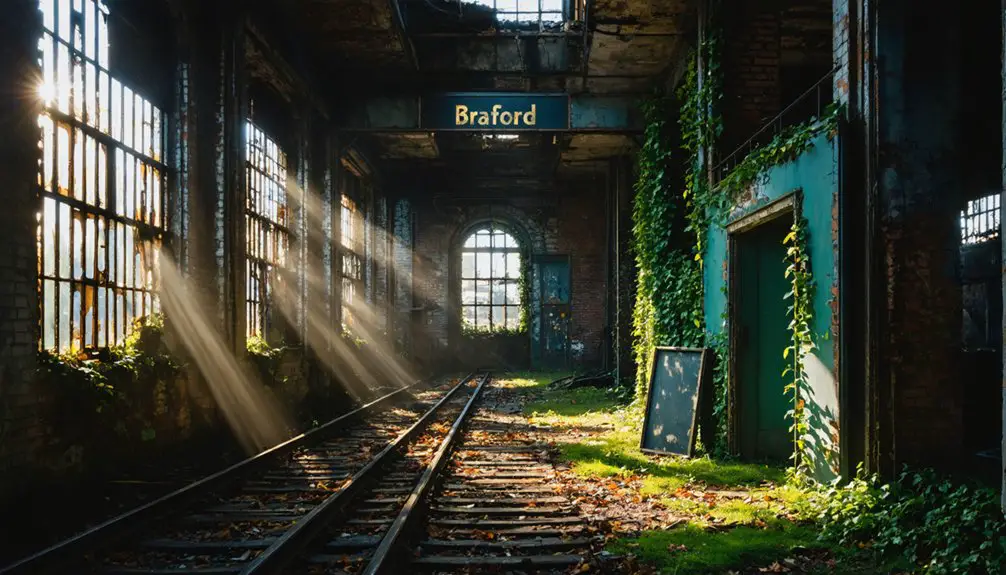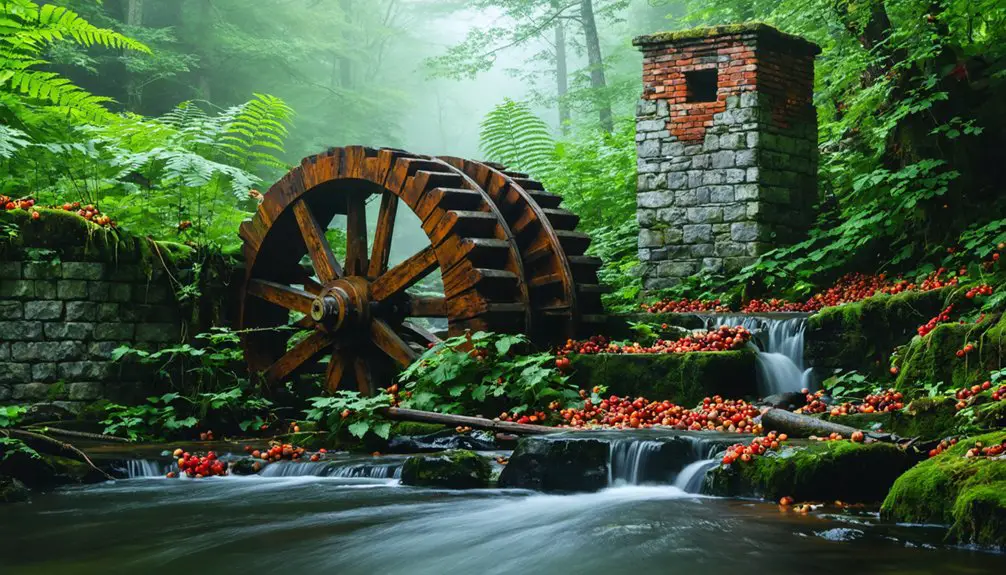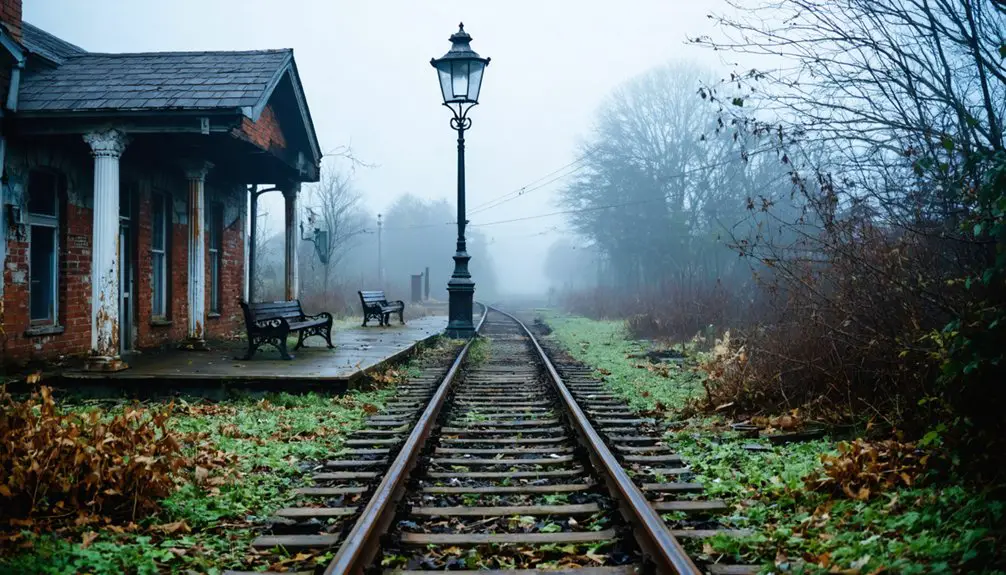You’ll find Bradford’s abandoned remains tucked away in western Rhode Island, where stone foundations and defunct mill structures reveal a colonial settlement that thrived from the 1730s through the early 1900s. The ghost town’s most striking features include preserved wells, agricultural stone walls, and the ruins of Gardner’s Mills. While some visit for the “Lady in White” ghost stories, Bradford’s true intrigue lies in its perfectly preserved glimpse into New England’s colonial past.
Key Takeaways
- Bradford was a mill village established in 1732, centered around Gardner’s Mills, before declining due to economic hardships and industrial closures.
- The Great Fire of 1922 accelerated Bradford’s abandonment, along with the closure of essential infrastructure like the post office and railroad depot.
- Archaeological remains include stone foundations, wells, water systems, and industrial equipment buildings that showcase the town’s colonial and agricultural heritage.
- Local supernatural legends include sightings of the “Lady in White” at Burlingame State Park and Peleg Walker’s spirit near the factory site.
- Stone structures, including boundary walls and building foundations, have survived centuries of abandonment, providing evidence of Bradford’s colonial settlement patterns.
The Origins and Settlement of Bradford
While the precise founding date remains uncertain, Bradford’s origins trace back to the late 1600s when the Harrington family (also known as Herendin) first settled in what would become Smithfield Woods, Rhode Island.
The settlement patterns followed typical colonial development, with families establishing themselves in this heavily forested, remote area where they could access natural resources and maintain relative autonomy. The settlers utilized an ancient Threshing Rock formation that existed before their arrival. Like the Newport slave ships that operated from Rhode Island’s coast, the early colonists relied heavily on maritime trade and resources.
You’ll find the naming evolution particularly interesting, as the town’s identity transformed through linguistic changes over time.
The Harrington family name gradually shifted through various forms – Herendon, Herington, and finally to Hanton – a unique example of how colonial place names evolved through oral tradition.
This evolution reflects the cultural and linguistic changes that shaped early New England communities.
Daily Life in Early Colonial Bradford
As settlers established themselves in Bradford during the early colonial period, they faced a delicate balance between individual autonomy and communal responsibility.
Daily survival meant managing your own 20-acre plot while contributing portions of your harvest to support fellow colonists and local governance. During disease outbreaks, the town council’s authority extended to establishing quarantines and seizing property if needed.
Managing your plot of land meant both personal sustenance and supporting the greater community through harvest contributions.
You’d spend your days tending crops, watching for wild animals, and maintaining shelter, all while maneuvering the psychological weight of supernatural fears. Life was especially demanding for women who often bore ten to fifteen children to help work the land.
Family dynamics centered on working together to overcome harsh wilderness conditions, from avoiding poisonous plants to fighting off illness.
Though you’d farm independently, you’d rely on neighbors during crises, following Bradford’s regulations that kept settlements close for mutual protection.
Despite the challenges, this arrangement offered opportunities for social advancement that weren’t possible in England, especially if you started as a servant.
The Gradual Decline and Abandonment
Despite Bradford’s promising start as a colonial settlement, economic forces began dismantling the community’s fabric in the late 19th century.
You’ll find that economic factors like the closure of sawmills, gristmills, and textile operations dealt devastating blows to local employment. As jobs vanished, community dynamics shifted dramatically, with families relocating to more prosperous areas. Similar to the Great Fire of 1922 that devastated other communities, natural disasters accelerated Bradford’s decline. Much like Hanton City ruins in Rhode Island, remnants of foundations and stone walls mark where life once thrived.
Here’s what sealed Bradford’s fate:
- The shutdown of traditional industries left residents without steady income sources
- Agricultural ventures struggled to remain viable, forcing farmers to abandon their lands
- Key infrastructure, including the post office and railroad depot, couldn’t survive the dwindling population
Today, you’ll see nature reclaiming Bradford’s once-bustling streets, with forest growth obscuring old foundations and cellar holes – silent testimony to a community that time forgot.
Physical Remains and Archaeological Evidence
At Bradford’s ghost town site, you’ll find extensive stone foundations marking where colonial homes and structures once stood, with many cellar holes still featuring their original stone steps.
The site’s wells remain remarkably intact, offering valuable insights into the settlement’s water management systems and daily life routines. Like the early settlers who engaged in farming and tanning, the remaining structures reveal a self-sustaining community focused on agriculture and trade.
Agricultural remnants include stone bases of corn cribs and boundary walls that outline former farmsteads, though their wooden superstructures have long since deteriorated.
Stone Foundations Still Stand
Stone sentinels of Bradford’s past remain scattered across the abandoned settlement, where durable foundations and walls tell the story of a once-thriving colonial community.
Similar to the remains found in Hanton City, Rhode Island, these stone remnants stand as testament to early New England settlements. Like the stone chambers found throughout Massachusetts, these structures showcase the region’s rich history of early stone construction.
You’ll find evidence of substantial stone construction throughout the site, with cellar steps and multi-room foundations revealing the archaeological significance of these early American dwellings.
While wooden structures have long since vanished, these lasting stone remnants provide essential insights into colonial life:
- Large house foundations with kitchen cellars suggest prosperous homesteads
- Stone bases of corn cribs indicate agricultural operations
- Networked stone walls mark property boundaries and field enclosures
Dense vegetation now shrouds many features, but you can still trace the settlement’s layout through these enduring stone structures, which have withstood two centuries of abandonment.
Wells and Water Features
Among Bradford’s enduring structural elements, the settlement’s water management features offer compelling archaeological evidence of colonial ingenuity.
You’ll find a remarkably preserved well nestled in the wooded area near house foundations, alongside a defunct dam that once served the community’s irrigation needs. These water management structures highlight the settlers’ sophisticated approach to sustaining their agricultural lifestyle.
Near the foundations, you’ll discover cellar steps and elevated corn cribs that protected stored goods from moisture damage.
While time has obscured many features beneath vegetation, the stone construction of wells and dams has withstood centuries of abandonment. Recent studies suggest some water features may have incorporated hand-laid stone structures, similar to those found at other New England sites.
Archaeological studies also suggest possible ceremonial practices tied to water sources, as evidenced by unusual root cellar designs and stone enclosures aligned with solar events, reflecting both practical and spiritual relationships with water.
Surviving Agricultural Structures
Physical remnants of Bradford’s agricultural heritage paint a compelling picture of colonial farm life through scattered but significant structural remains.
You’ll find fascinating examples of early agricultural architecture in the preserved foundations, where cellar steps and kitchen basements showcase period-specific preservation techniques. The surviving structures reveal the area’s evolution from basic farming to mechanized agriculture.
- Farmhouse foundations with intact granite and brick construction demonstrate the Bradford family’s influence on local building styles.
- Industrial equipment buildings, complete with abandoned wool processing machinery, highlight the shift to mechanized farming.
- Stone piers that once supported corn cribs and livestock pens provide archaeological evidence of diverse agricultural activities.
These architectural remnants help you piece together Bradford’s rich farming history while exploring the ghostly remains yourself.
Ghost Stories and Local Legends
While Bradford’s historical ruins speak of its industrial past, the town’s ghostly legends reveal a rich tapestry of supernatural folklore that’s evolved since the 1880s.
You’ll find the area’s most famous spectral legends centered around Hanton City, which earned its “Haunted City” nickname from an 1880s Providence Journal article.
Through decades of oral tradition, ghostly encounters have become deeply woven into local culture, particularly at Burlingame State Park where campers report sightings of the mysterious “Lady in White.”
Generations of Bradford locals share tales of the Lady in White, whose ethereal presence haunts the shadowy paths of Burlingame State Park.
The spirit of Peleg Walker is said to roam near the old factory site, while the playful ghost of Mary Mills Crandall adds another layer to the supernatural narrative.
These stories connect Bradford’s past to Rhode Island’s broader haunted heritage.
Natural Reclamation and Preservation

Since the Bradford Dyeing Association ceased operations, nature has steadily reclaimed the 546-acre industrial site, transforming it into a thriving ecosystem managed by the Westerly Land Trust.
You’ll witness remarkable habitat restoration as forests have overtaken abandoned industrial spaces, while former wastewater lagoons have evolved into the vibrant Grills Preserve Pond, supporting diverse aquatic life.
- The site’s ecosystem recovery connects wildlife corridors to the Pawcatuck River, where you can spot sunfish, chain pickerel, and largemouth bass.
- You’re free to explore protected nature preserves, though some areas require monitoring due to historical contamination.
- The land’s split ownership between Rockingham Estate and Westerly enables varied conservation approaches, ensuring long-term preservation of these rewilded spaces.
Exploring Bradford’s Historical Sites Today
Today you can explore Bradford’s rich historical legacy through a variety of engaging experiences, from seasonal ghost tours to self-guided walks among centuries-old ruins.
You’ll discover stone foundations and cellar holes that reveal the town’s original layout, while interpretive signs help you understand the significance of each site.
Join guided tours that blend historical facts with local folklore, typically lasting 1-2 hours and suitable for all ages.
Experience Bradford’s past through engaging guided tours where history meets storytelling, perfect for families seeking adventure together.
Don’t miss the colonial-era cemeteries, where weathered tombstones display traditional New England iconography and tell stories of the town’s founding families.
Regional museums showcase artifacts from Bradford’s heyday, and you’ll find convenient parking and maintained walking paths at major historical sites.
Remember to check visitor information centers for maps and brochures before setting out.
Bradford’s Place in Rhode Island History
Bradford emerged as a quintessential Rhode Island mill village in 1732, anchored by the establishment of Gardner’s Mills along the Pawcatuck River in 1758.
The village’s industrial heritage mirrors Rhode Island’s broader shift to factory-based economies, with its development concentrated along Main Street between the mill and railroad tracks.
You’ll find Bradford’s significance deeply rooted in both economic and political spheres.
Here’s what makes Bradford a notable piece of Rhode Island history:
- The village exemplifies the state’s evolution from rural hamlets to industrial centers.
- Its connection to William Bradford, a Revolutionary War leader who shaped Rhode Island’s wartime response.
- The settlement represents the transformation of Indigenous lands into colonial manufacturing hubs, following conflicts like King Philip’s War.
Frequently Asked Questions
Were Any Bodies or Human Remains Ever Found in Bradford’s Ruins?
You won’t find any confirmed burial sites or human remains in the ruins. Historical investigations and official records show no documented discoveries of bodies in this location.
What Kinds of Artifacts Have Metal Detectorists Discovered Around Bradford?
You’ll find metal detectorists have uncovered artifacts of historical significance, including miner tags, coke oven bricks, porcelain doorknobs, personal buckles, and old lighters – each requiring careful artifact preservation.
Are There Any Remaining Family Descendants of Bradford’s Original Settlers?
Picture old family trees with faded branches – you’ll find it’s hard to confirm living descendants today. While historical records mention the Harrington family lineage, there’s no definitive proof of direct survivors.
Was Bradford Ever Connected to Any Documented Criminal Activity or Murders?
You won’t find any documented criminal history or unsolved cases connected to this location – historical records don’t reveal any murders or significant criminal activity in Bradford’s past as a settlement.
Did Native American Tribes Have Settlements in Bradford Before Colonial Development?
You’ll find the Narragansett and Pokanoket peoples maintained native settlements in the area, with their fluid villages supporting fishing, farming, and foraging activities until colonial interactions disrupted their traditional way of life.
References
- https://www.youtube.com/watch?v=kpy7zlXYrAU
- https://smithapplebyhouse.org/arethereghosts/
- https://www.visitrhodeisland.com/things-to-do/haunted-rhode-island/
- https://www.youtube.com/watch?v=InYM3x9RdZI
- http://ahistorygarden.blogspot.com/2012/04/mill-seat-at-woodville-vestiges-of.html
- https://sentinelhillpress.com/wp-content/uploads/2016/08/supernatural-folklore-of-rhode-island.pdf
- https://preservation.ri.gov/sites/g/files/xkgbur406/files/pdfs_zips_downloads/survey_pdfs/westerly.pdf
- https://scholarworks.uno.edu/cgi/viewcontent.cgi?article=1710&context=td
- https://digitalcommons.liberty.edu/cgi/viewcontent.cgi?article=7518&context=doctoral
- https://www.worldhistory.org/article/1722/daily-life-in-colonial-america/



